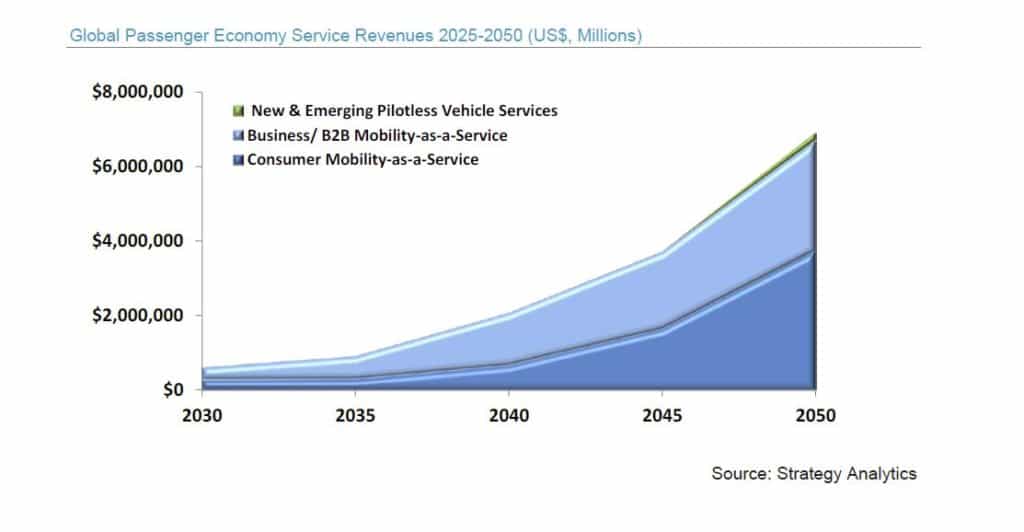 Autonomous driving and smart city technologies will enable the new Passenger Economy, gradually changing entire industries and inventing new ones. The Passenger Economy, sponsored by Intel and written by Strategy Analytics’, Roger Lanctot (winner of AUTO Connected Car News’ Tech CARS Award) predicts an increase from $800 billion in 2035 to $7 trillion by 2050 in revenues from mobility services.
Autonomous driving and smart city technologies will enable the new Passenger Economy, gradually changing entire industries and inventing new ones. The Passenger Economy, sponsored by Intel and written by Strategy Analytics’, Roger Lanctot (winner of AUTO Connected Car News’ Tech CARS Award) predicts an increase from $800 billion in 2035 to $7 trillion by 2050 in revenues from mobility services.
Passenger + Technology = Profit
Intel, seeking to enable the computing and connectivity technologies that will drive this market, paid Strategy Analytics as a partner to validate the hypothesis that the Passenger Economy is going to be profitable and companies need the power of Intel tech behind it.
The Passenger Economy is the economic and societal value that will be generated by fully autonomous (SAE Level five) self-driving vehicles. A term coined by Intel and examined by Strategy Analytics to represent the value of products and services derived from the use of fully autonomous self-driving driverless vehicles.
In other words, there is going to be a lot of money made and new services offered.
Autonomously operated vehicles commercialization will proliferate by 2040 – generating an increasingly large share of the projected value and heralding the emergence of instantaneously personalized services.
Business use of Mobility-as-a-Service (MaaS) is expected to generate US$3 trillion in revenues, or 43 percent of the total passenger economy. While consumer use of Mobility-as-a-Service offerings is expected to account for US$3.7 trillion in revenue or nearly 55 percent of the total passenger economy.
An addtional $200 Billion of revenue is expected to be generated from rising consumer use of new innovative applications and services that will emerge as pilotless vehicle services expand and evolve.
More Free Time to Buy More Stuff & Services
The good news is that self-driving vehicles could free more than 250 million hours of consumers’ commuting time per year in the most congested cities in the world.
That’s when new services will be created called, car-venience such as onboard beauty salons to touchscreen tables for remote collaboration, fast-casual dining, remote vending, mobile healthcare clinics and treatment pods, and even platooning pod hotels. The vehicles then become transportation experience pods.
When AUTO Connected Car News’ editor, Lynn Walford interviewed Intel’s Kathy Winter for USA Today GET Creative, she said, “When drivers become riders they will need to have something to do. That’s where Intel is working to provide 5G data connections to supply a steady stream of entertainment and data for activities on the road.”
Strategy Analytics predicts the media and content producers will develop custom content formats to match short and long travel times.
Jono Anderson, principal at KPMG’s Strategy and Innovation said that purpose will influence the design of vehicles, “Cars will be created for the mission of the car such as delivery, recreational or business. Some will be designed for long trips where the rider can sleep or work.”
We Know Where You’re Going and What You Want to Buy
The Intel report notes that location-based advertising will become more keenly relevant, and advertisers and agencies will be presented with a new realm of possibilities for presenting content brands and location.
Then to entice people to become part of a group, employers, office buildings, apartment complexes, university campuses and housing estates will offer MaaS to add value to and distinguish their offer from competitors or as part of their compensation package.
The report states that the emergence of the Passenger Economy marks the greatest transition in human mobility since humans left their horses for a new relationship with the horseless carriage. The elimination of the need for a driver shifts human transportation behaviors freeing time while improving the safety and economics of the mobility experience.
Great Except—Could Be Disastrous in Case of Disaster
There are some problems with hypothesis of greater safety, especially in the case of an “Act of God.” As the passenger economy grows and there are fewer cars owned by individuals in the case of a natural disaster, a super storm, hurricane, wild-fire or major earthquake, when networks break down and the connections of the vehicles to main cloud systems there will be no way to get a ride to get of the path of the impending disaster.
“Owning your own car provides the greatest freedom. When multiple mobility choices are available. It’s going to be hard to give up,” said Egil Julissen, director of research and principal analyst automotive technology at IHS Markit, “In the case of an emergency, you can still get out and drive your car.”
—–
There is still a great value in asking “What will people do in autonmous self-driving cars? “